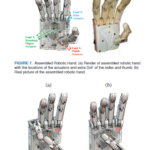Paper, Development of a robotic hand usingbioinspired optimization for mechanicaland control design: UnB-Hand
For the last four decades, the development of robotic hands has been the focus of severalworks. However, a small part of those approaches consider the exploitation of parallelism of FPGA-based (Field Programmable Gate Arrays) systems or discuss how using bioinspired optimization algorithmscould improve the mechanical and controller components. This work considers developing a bioinspiredrobotic hand that achieves motion and force control with a logic hardware architecture implementedin FPGA intended to be replicated and executed with suitable parallelism, fitting a single device. Thedeveloped robotic hand prototype has five fingers and seven DoF (Degrees of Freedom). Using bioinspiredoptimization, such as PSO (Particle Swarm Optimization), both the rigid finger mechanism and theimpedance controller were optimized and incorporated the results in several practical grasping experiments.The validation of this work is done with the Cutkosky grasping taxonomy and some grasping experimentswith interference. The tests proved the proficiency of this works for a wide range of power and someprecision grasp. The reader can see the experiments in the attached videos.
Learn about our two Decals!
 Click here to find out more about our Fall Bioinspired Design Decal and our Spring Bioinspired Design in Action Decal – ALL MAJORS are welcome.
Click here to find out more about our Fall Bioinspired Design Decal and our Spring Bioinspired Design in Action Decal – ALL MAJORS are welcome.Berkeley BioDesign Community
 Click here to learn about the BioD: Bio-Inspired Design @ Berkeley student organization or here to signup for more info.
Click here to learn about the BioD: Bio-Inspired Design @ Berkeley student organization or here to signup for more info.Search
Student Login




I imagine that the neurological circuits underlying these processes are governed by both 2d spacing maps with their brains as…
to reduce the impact of car accidents, it may be possible to study the force diverting physics of cockroaches to…
you see this type of head-bobbing stability in many avian creatures related to pigeons like chickens. the head ability to…
not like they taught horses how to run! this is an example of convergent evolution where both sea creatures and…
The brain functions in a similar way with neuronal connections. our brains are able to utilize the multiplicity of connections…